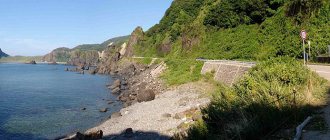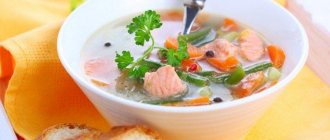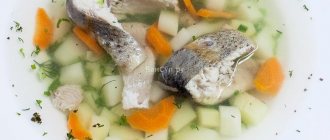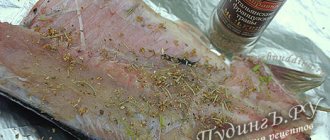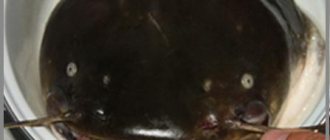Japanese pizza
In fact, okonomiyaki is a Japanese “pizza”, fried flatbread with a variety of toppings. True, it is prepared completely differently from the Italian delicacy that is familiar to us. From Japanese, “okonomiyaki” translates something like this: “to fry what you want/love.” This gives a lot of room for imagination.
In restaurants in the Land of the Rising Sun, these flatbreads are fried on special stoves (teppan). These flat metal slabs are usually built directly into the table at which visitors sit. Those who come choose the filling, and the chef prepares the order right before their eyes. There are cafes where people can make their own okonomiyaki, similar to Asian “samovars” with boiling broth and a variety of ingredients in individual bowls.
This dish is quite popular in Japan and is an affordable fast food, like our ubiquitous shawarma.
Making okonomiyaki and monjayaki at home
Making these Japanese savory pancakes at home isn't that difficult, and since you can make your own okonomiyaki and monjayaki, you can't go wrong if you already know the basics.
This is an amazing kitchen to impress your guests or just have fun while enjoying your leisure time.
However, you may need to invest in a teppanyaki grill to make the best okonomiyaki and monjayaki pancakes at home.
PAY for these Robata grills for Japanese cuisine
What is
Traditionally, the flatbread consists of water, eggs, flour and cabbage (sometimes also noodles). When it is fried on a teppan in the form of a pancake (fried on both sides), okonomiyaki is greased with a special condensed soy sauce and sprinkled with shavings or dried tuna powder and seaweed on top.
The dish originated from the Chugoku and Kinki regions. As it spread throughout the country, the traditional okonomiyaki recipe began to acquire various variations, depending on what food was popular in a particular province.
Let's start cooking
A step-by-step okonomiyaki recipe with photos will help you quickly navigate the cooking process and get an excellent result.
You should start with preparing seafood. Pour boiling water over the squid carcass, remove the skin and cook in boiling salted water for no more than two minutes so that the meat does not become tough and rubbery. Cut it into small strips. Then we cook the shrimp and remove their shells. Choose the size and quantity of these shellfish yourself, depending on what you like best.
Boil the egg noodles until tender, then cut them into several pieces so that they are not too long. Shred the cabbage, cut the onion into small cubes, and the ham into small strips.
Place noodles, squid meat, shrimp, cabbage and onion in a large, spacious bowl. Salt and pepper to taste, then mix thoroughly. Cabbage may produce more juice than necessary, so you can carefully drain it.
In another cup, beat the egg with water, adding about 2/3 cup of it. Gradually add flour and stir until the dough is uniformly thick. After that, combine it with the ingredients from the first bowl and mix thoroughly.
Place the resulting mixture in portions on a hot frying pan, leveling it to the same size with a spatula. Don’t forget to put the ham on top, then fry on both sides until fully cooked (as in the photo). When serving, okonomiyaki is sprinkled with grated cheese and fresh chopped herbs. As you can see, the recipe for Japanese okonomiyaki pizza is really simple.
Classic recipe
If you manage to get shavings or powder from dried tuna, as well as seaweed, then you can make a classic Japanese “pizza”. People leave a wide variety of reviews about the okonomiyaki tuna recipe. But many find it special and authentic.
To do this, do not add anything to the dough except cabbage. The pancakes are fried on both sides until cooked, and then coated with specially condensed soy sauce. To make it like this, you just need to add starch to it until its consistency resembles melted chocolate. And then sprinkle with shavings or powder.
Okonomiyaki recipe
This dish will take about 90-120 minutes to prepare. The following ingredients are for 4 servings:
For the okonomiyaki sauce:
Preparation
Prepare all ingredients.
Preparing the dough
1. In a large bowl, combine 120 grams of plain flour, ¼ teaspoon salt, ¼ teaspoon sugar and ¼ teaspoon baking powder, then mix everything thoroughly.
2. Peel and grate nagaimo in a small bowl. Keep in mind that nagaimo is very slimy and sticky, so hold it tightly when you rub it.
3. Add grated nagaimo and dashi to a bowl.
4. Mix everything together until smooth. Cover the bowl with plastic wrap and leave it in the refrigerator for at least one hour.
Making okonomiyaki sauce
1. Gather together all the ingredients needed for the okonomiyaki sauce.
2. Mix 1 ½ tbsp. l. sugar, 2 tbsp. l. oyster sauce, 4 tbsp. l. ketchup and 3 ½ tbsp. l. Worcestershire sauce in a small bowl. Stir everything until the sugar is completely dissolved.
Cooking okonomiyaki
1. Remove the core of the cabbage and chop it. Set aside to allow excess moisture to evaporate slightly.
2. Cut the pork belly into slices and set aside.
3. Remove the dough from the refrigerator and add 4 large eggs, ½ cup (8 tbsp) leftover tempura and ¼ cup (4 tbsp) pickled red ginger. Mix well until smooth.
4. Add a third of finely chopped cabbage to the dough. Mix well before adding the rest.
Frying okonomiyaki
1. Heat vegetable oil in a large skillet over medium heat. When the pan reaches 200 degrees, melt the butter to grease the pan. The Japanese like to cook thicker okonomiyaki (the final thickness is about 2 cm). If you are new to making okonomiyaki, make them thinner to make flipping easier.
2. Place 2-3 sliced pork on top of the okonomiyaki and cook, covered, for 5 minutes.
3. When the bottom side is nicely browned, flip it over.
4. Gently press the okonomiyaki to shape. Cover with a lid and cook for another 5 minutes.
5. Flip one last time and cook uncovered for another two minutes. If you are going to cook more, then place the resulting okonomiyaki on a plate.
Okonomiyaki in the oven
Okonomiyaki does not have to be fried; this Japanese pizza can also be baked in the oven. Then you get a kind of open cabbage pie. Mushrooms, chicken and bell peppers are ideal for this as an addition.
The mushrooms need dry porcini mushrooms, they should be soaked. When they get wet, drain the water, leaving a glass - it will be useful for the dough, which will taste like mushrooms.
Finely chop cabbage, mushrooms, chicken and bell peppers. In a large bowl, mix the egg with flour and mushroom juice, add cabbage and a spoonful of soy sauce.
Now let's get to the filling. Fry the mushrooms, chicken and peppers in a hot frying pan for five minutes, then place it on a greased baking sheet in the shape of a square, leveling it with a spatula. We form a layer of cabbage dough on top and place the “pizza” in the oven for thirty minutes at 200 degrees. After thirty minutes, take out the okonomiyaki and divide it with a spatula into 8-9 serving pieces, carefully turn each of them over and put it back in the oven for half an hour. This version of okonomiyaki should be served with soy sauce, mayonnaise and fresh herbs.
We hope that you liked the okonomiyaki recipe with photos, and this dish will take its rightful place in your daily home menu.
Okonomiyaki's roots and regional differences
Okonomiyaki, being the more prominent of the two dishes, has not only evolved over the centuries, but has also become a widespread delicacy in various regions of Japan, each with its own blend and flavor.
It's interesting to know that places like Tsukishima, Hinase, Tokushima Prefecture and some other regions have their own unique style of making okonomiyaki meat and vegetable pancakes.
The development of okonomiyaki is a miracle in itself. Now let's look at the different variations of this savory Japanese pancake.
Okonomiyaki comes in different styles of preparation:
- Kansai/Osaka Style
- Hiroshima style
- Tsukishima style
- Hamamatsu style
- Okinawan style
- Hinase in Okayama style
- Kishiwada in Osaka style
- Fuchu, Hiroshima style
- Tokushima style
This is a text overlay of the original work. Okonomiyaki! user SteFou! on Flickr in the cc section. What a beautiful dish!
Kansai/Osaka Style
This version of okonomiyaki is the most popular of all okonomiyaki pancakes in all of Japan.
Taking apart this kitchen won't be easy since it has a lot of basic ingredients, and since its name implies that you can customize it, it becomes even more challenging.
- Let's start with the batter; it is made from wheat or buckwheat flour and is a kind of base for the entire pancake.
- Then other ingredients include a tuberous root vegetable called nagaimo, which is a grated sweet potato.
- dried seaweed or tuna extract called dashi, or sometimes they just use water as a substitute ingredient
- shredded cabbage (perfect for okonomiyaki!) and eggs.
- Additional ingredients include mochi or cheese, konjac, vegetables, shrimp, squid, octopus, thin strips of pork belly meat (much like bacon) and green onions.
Various slang expressions for okonomiyaki may also include "Osaka soul food", "Japanese pizza", pancakes or omelette.
Okonomiyaki also has very tasty toppings that add even more flavor to the already existing flavors, and these seasonings include:
- beni shoga or pickled ginger
- Japanese mayonnaise
- katsuobushi or what is also known as mackerel flakes
- aonori (algae flakes)
- and Worcestershire sauce or otafuku/okonomiyaki sauce.
Okonomiyaki is cooked on a teppanyaki grill and you can go to a staffed or grilled restaurant where the latter will give you the opportunity to make your own okonomiyaki.
There are other variations of okonomiyaki where it is served with an extra layer of fried udon/yakisoba and this is called modan-yaki. Negiyaki, on the other hand, is a variation of okonomiyaki with lots of green onions.
Hiroshima style
This style of okonomiyaki is very different from its Osaka counterpart, and while the latter's ingredients are mixed, the former is made up of layers of rock formations detailing the geological time frame.
Layers usually consist of:
- bread flour
- cabbage
- pork (or seafood such as octopus, squid or shrimp)
- and cheese.
- It is usually topped with udon or yakisoba noodles, much like modan-yaki.
- plus there's enough okonomiyaki sauce to dispel all your blues simply because it's so delicious.
This okonomiyaki has such a unique blend and taste that it eloquently echoes the Japanese idiomatic expression "'より団子", which translates to "dumplings, not flowers"; and this can usually mean someone who favors substance over style or is a practical person.
In my overall opinion, the practicality of layering the okonomiyaki ingredients rather than mixing them enhances its flavor even more!
The Hiroshima style of cooking okonomiyaki is sometimes called Hiroshima-yaki or Hiroshima-okonomi.
Tsukishima style
The restaurant specializes in monjayaki as it is believed that this is where monjayaki was born, but the restaurants also serve okonomiyaki.
They even named the main street here "Monja Street" as a reference to the monjayaki recipe.
Hamamatsu style
They make takuan, a pickled daikon radish that can hardly be considered a type of okonomiyaki, except that it looks like vegetable pancakes.
Okinawan style
This is a very simple type of okonomiyaki called Hirayachi, but you will find it more often at home than in any restaurant in Okinawa.
Hinase in Okayama style
Chefs from this region love to add oysters to okonomiyaki and improve the recipe by calling it kaki-oko, which is their version of the famous cuisine.
Kishiwada in Osaka style
Their version of okonomiyaki is called kashimin-yaki (カシミヤキ), and the regular pork added to the recipe is replaced with chicken and fat, giving kashimin-yaki a unique flavor.
Fuchu, Hiroshima style
This version of okonomiyaki also replaces the pork belly meat with ground beef or pork.
Tokushima style
This is a type of mixed okonomiyaki.
Hashimaki
It's a kind of okonomiyaki, but hashimaki is served on chopsticks and ready to eat


